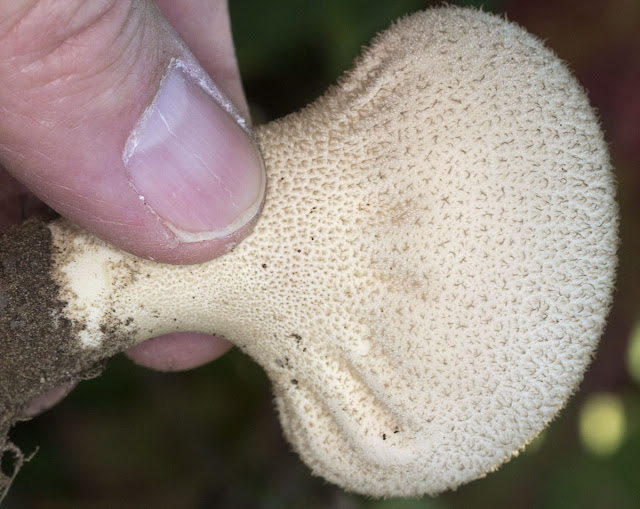 |
| Orpington Field Club walking through Farningham Wood. 2 October 2011. |
This trip took place after a week of unseasonably hot and dry weather, which is bad news for a fungus hunt. It's one of the few occasions when you hope that there has been plenty of rain recently. So we found fewer fungi than hoped, and many of them were dried up and dead-looking. But it wasn't all bad news.
The woods are full of sweet chestnut trees, whose canopies give a lovely green-gold light in sunshine. But there is an excellent mixture of other trees. Aspens and willows near the seasonal ponds; oaks and hornbeams elsewhere. There has been a lot of coppicing in the past, and although we didn't see any freshly coppiced areas, there was a big pile of cut trunks, so there is clearly management activity.
I took lots of photos of fungi, and a few other things, so I will show some here and some in a later post. Here are some of two different kinds of puffballs, both quite small and nothing like the giant puffball which is normally quite common in the woods.
The first, Scleroderma citrinum, has a hard and scaly skin; in fact its name means "hard skin." You can see that it has been split apart, and the photo on the right shows a cross-section, with the black spores developing inside.
When they mature, puffballs develop a hole in the top. The spores dry out, and any blow on the skin produces a powdery puff.
The second puffball, Lycoperdon foetidum, shown below, has a very different skin, and seems to be covered with small spikes, though they are quite soft to the touch. This one was growing on a layer of wood chippings, either chestnut or oak, where we found a few interesting fungi.
The chippings were under a power line, and were obviously the result of keeping the lines clear of vegetation.
 |
| Puffball, Lycoperdon foetidum. Farningham Wood with the Orpington Field Club, 2 October 2011. |
 |
| False Death Cap, Amanita citrina var. alba. Farningham Wood with the Orpington Field Club, 2 October 2011. |
 |
| Death Cap, Amanita phalloides. Farningham Wood with the Orpington Field Club, 2 October 2011. |
Like the False Death Cap, it has a distinctive odour, and it's quite a different one. But an odour of what? I picked up three different descriptions of the smell: scrambled eggs, old faded roses, and stale urine. Clearly there is something organic and aromatic there.
Finally for this page, one of the wood's invertebrates; a fairly common hoverfly, found near one of the seasonal ponds, none of which had standing water, though the bottoms of some were still muddy.
| Hoverfly, Myathropa florea. Farningham Wood with the Orpington Field Club, 2 October 2011. |


No comments:
Post a Comment